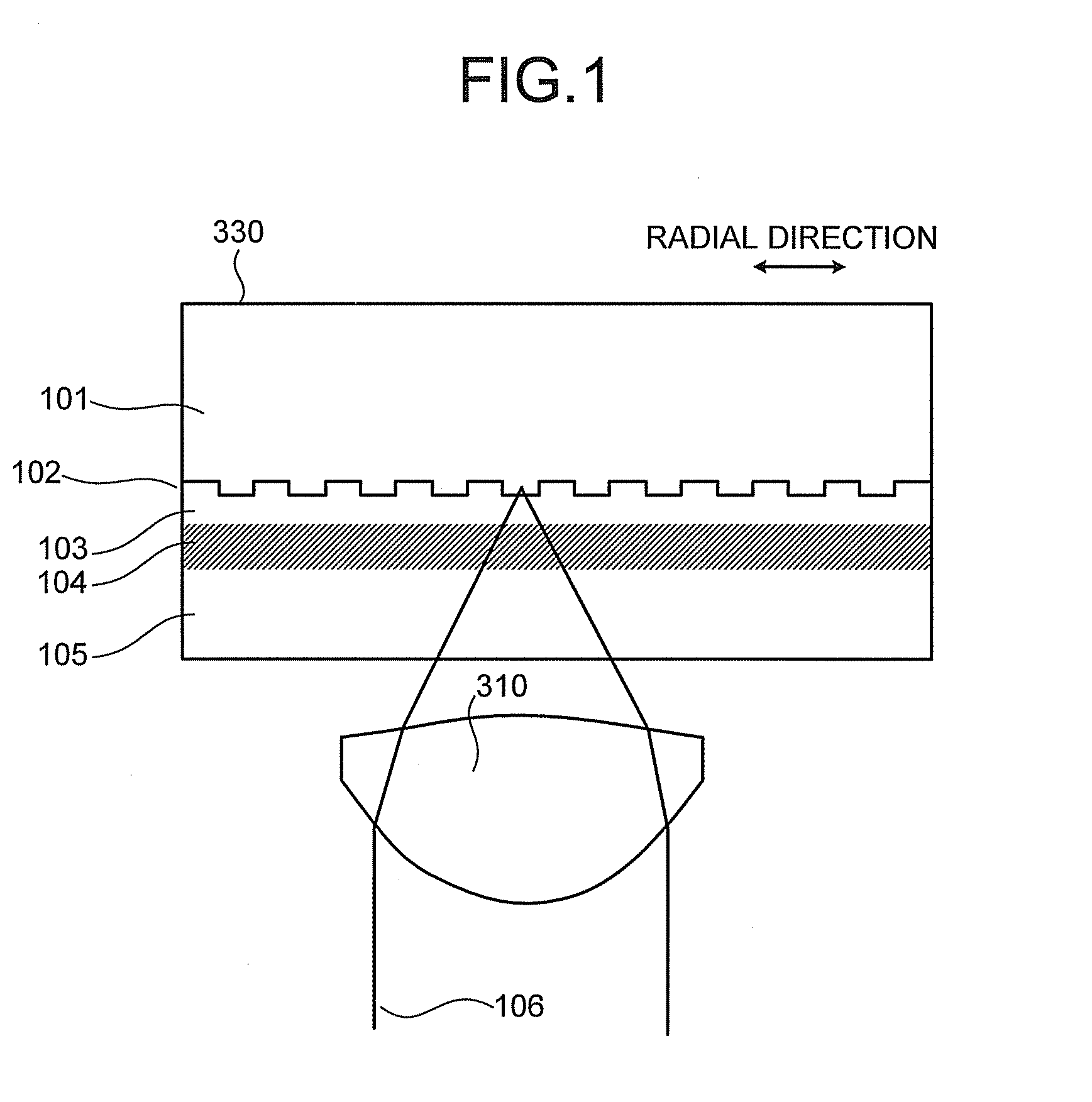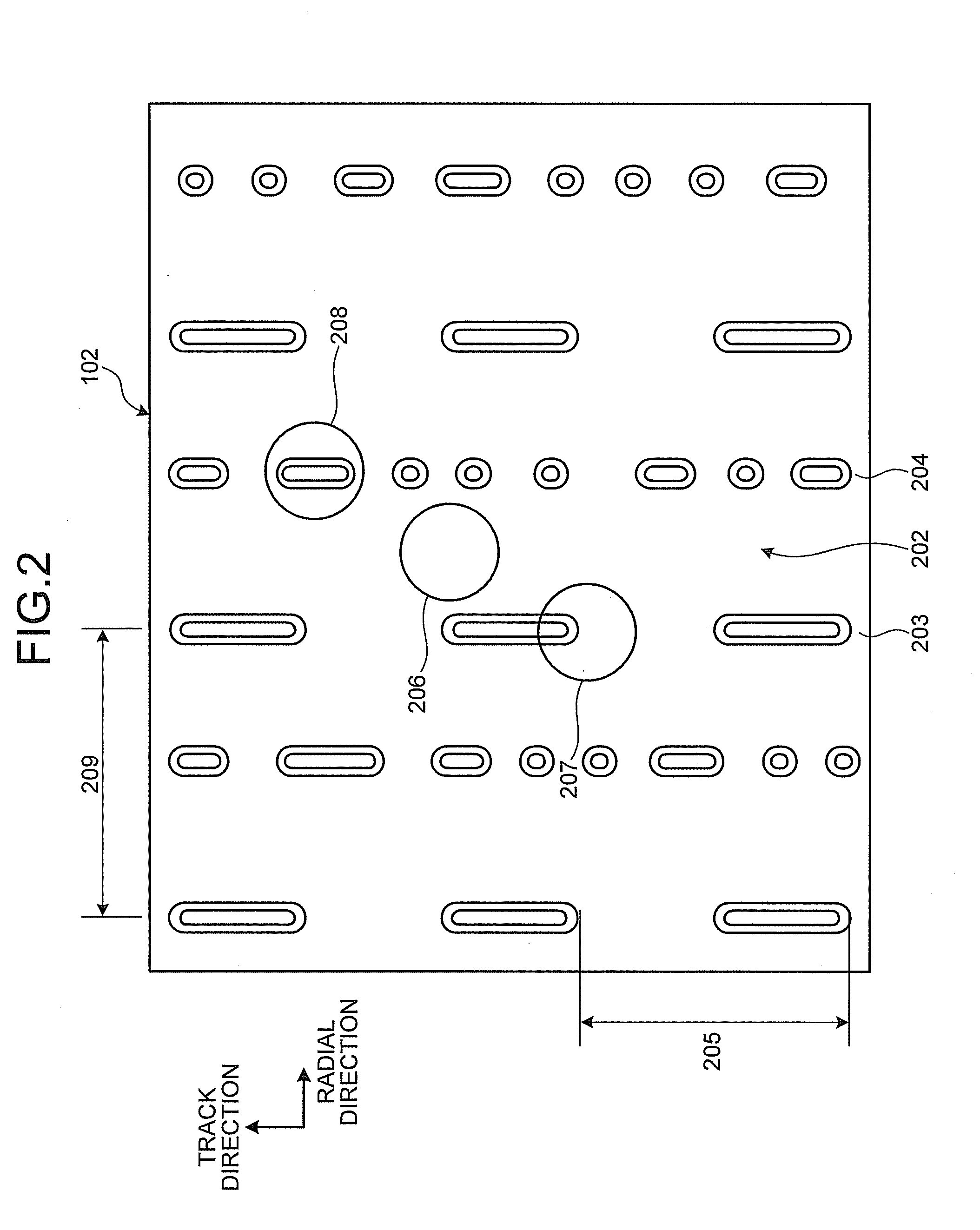Medium, apparatus, and method of recording optical-information
a technology of optical information and recording medium, applied in the direction of data recording, recording/reproducing/erasing using optical interference patterns, instruments, etc., can solve the problems of insufficient follow-up accuracy, inability to shorten the search time, and inability to achieve the effect of practical use of the record-playback apparatus
- Summary
- Abstract
- Description
- Claims
- Application Information
AI Technical Summary
Benefits of technology
Problems solved by technology
Method used
Image
Examples
first embodiment
[0041]Exemplary embodiments of the present invention are explained below in detail referring to the accompanying drawings. The present invention is not limited to the embodiments explained below. FIG. 1 is a cross sectional view of a holographic optical disk 330 according to a The holographic-optical-disk 330 includes a polycarbonate substrate 101, a transparent gap layer 103, a holographic-recording medium layer 104 in which information is recorded, and a protective layer 105 that protects the holographic-recording medium layer 104, layered in the order. The holographic-optical-disk 330 further includes a servo surface 102 formed on a surface of the substrate 101 that faces the holographic-recording medium layer 104, and the servo surface 102 includes guiding grooves or ridges (hereinafter, abbreviated as “patterns”) or pits for focusing servo control, tracking servo control, and following-up servo control formed thereon. The state shown in FIG. 1 is that an objective lens 310 foc...
second embodiment
[0118]FIG. 16 is a schematic view for explaining a configuration of an optical system in a record-playback apparatus for holographic-optical-disk according to a
[0119]The configuration of the holographic-optical-disk used by the record-playback apparatus according to the second embodiment is identical to that of the holographic-optical-disk according to the first embodiment.
[0120]The record-playback apparatus for holographic-optical-disk according to the second embodiment uses the collinear holographic recording method as with the first embodiment, where the information beam and the reference beam are coaxially arranged.
[0121]The optical system in the record-playback apparatus for holographic-optical-disk according to the second embodiment includes the semiconductor laser 301, the collimating lens 302, the diffraction grating 303 as the resonator, a spatial light modulator 1604, the spatial filter 327b, a spatial filter 327c, the diffraction grating 316, the polarization beam splitte...
third embodiment
[0133]The record-playback apparatus performs tracking servo control by the DPD method while following-up servo control is not performed, and performs tracking servo control using the signal intensity of the reflection from the following-up pit row 203 during following-up servo control.
[0134]During following-up servo control, two signals from each beam spot on the adjacent sectional acceptance surfaces 704c and 704d are input to the differential amplifier 722 in the tracking control unit 603. The differential amplifier 722 computes the difference between the two signals, and the resulting differential signal 708 is output as the tracking error signal.
[0135]The record-playback apparatus according to the third embodiment does not use the differential signal of two trace signals for the following reason. As shown in FIG. 10, when the servo beam 502 is misaligned, the light intensities of the reflections on the adjacent two sectional acceptance surfaces are different. Therefore, the rec...
PUM
| Property | Measurement | Unit |
|---|---|---|
| shift distance | aaaaa | aaaaa |
| distance | aaaaa | aaaaa |
| power | aaaaa | aaaaa |
Abstract
Description
Claims
Application Information
 Login to View More
Login to View More - R&D
- Intellectual Property
- Life Sciences
- Materials
- Tech Scout
- Unparalleled Data Quality
- Higher Quality Content
- 60% Fewer Hallucinations
Browse by: Latest US Patents, China's latest patents, Technical Efficacy Thesaurus, Application Domain, Technology Topic, Popular Technical Reports.
© 2025 PatSnap. All rights reserved.Legal|Privacy policy|Modern Slavery Act Transparency Statement|Sitemap|About US| Contact US: help@patsnap.com



